Cold Process Soap Recipe Beef Dripping
Cardinal Edge Wellness may collect a share of sales or other compensation from the links on this page. This comes at no additional price to you, and all the prices and availability are accurate at the time of publishing.
Get started with cold process soap making with tallow in just a few steps!
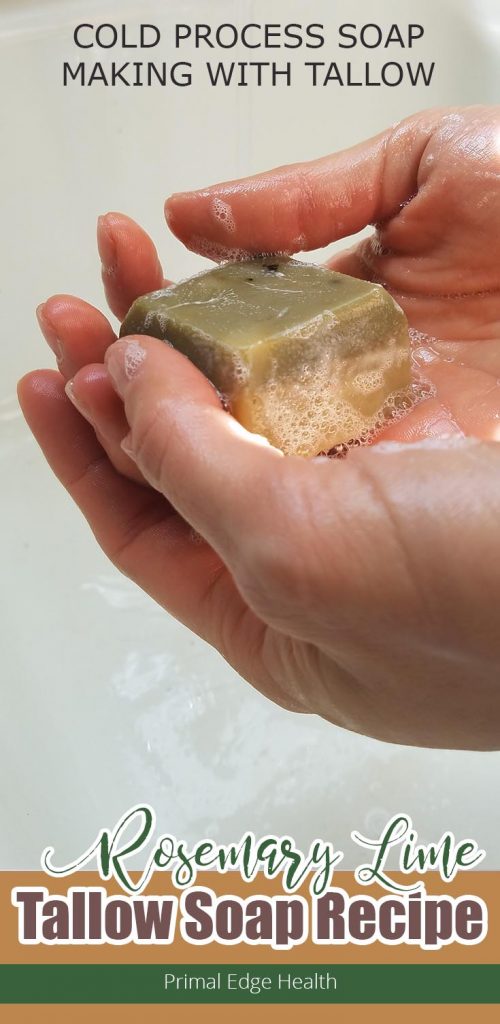
Did you e'er retrieve using a bar of fat can go out you lot feeling squeaky clean?
Using beef tallow in soap creates a very hard, long-lasting bar with a gentle lather. Information technology is an ideal ingredient for natural and DIY soaps.
I'd like to welcome Colina from Whet Stone Soapery who going to guide us through the procedure of cold process soap making with tallow in this guest mail service.
She makes is simple and straight forward and then we can all get the benefits of natural tallow soap in our own homes. You tin learn more virtually Loma on instagram and learn more nearly her soap and lip lotion in her etsy shop.
The History of Beefiness Tallow in Soap Making
When I tell people I make lather from grass-fed tallow their starting time reaction is "what is tallow." Subsequently I explain that tallow is the rendered and stable grade of beef fat, their 2nd reaction is "eew" as they imagine themselves rubbing a greasy bar of fat on their skin.
Believe it or not, this pure tallow soap recipe does wonders for sensitive skin!
If you want to brand soap without tallow, try this Common cold Process Lather for Beginners recipe instead.

Aboriginal History
No one knows exactly when lather was first created and by whom, but the earliest record of lather is from the Babylonians around 2800 B.C. Additionally, the Romans, Greeks, Celts and Egyptians each seemed to have developed soap independently of each other. Fable says that in aboriginal Rome, women were washing dress in the river at the base of Sappo Hill where animate being sacrifices were done. The runoff of creature fats would mix with the clay in the water and the women found that clothes became cleaner in this mixture.
For hundreds of years, this early on grade of soap was made from fats, oil and forest ash and was used mainly for cleaning wool. H2o poured through forest ashes leached lye from the ash, and this lye was boiled in a vat with animal fatty. The long process required an experienced lather maker who could test and suit the mix properly. Besides much lye meant the soap was harsh and would damage skin and fabrics. As well little lye and the soap would be greasy and never harden.
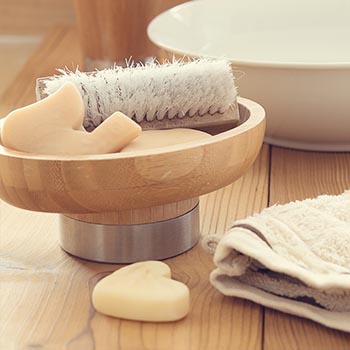
Soap for Personal Use
The use of soap for personal hygiene didn't seem to come up effectually until 18th century France when the pharmacist Nicolas LeBlanc synthesized a solution of sodium hydroxide. This man-fabricated lye was more reliable and easier to use than forest ash lye leading to soap become a more than affordable commodity for the common person.
These days there has been a resurgence of using tallow in soap making, perhaps due to the growing awareness of nose-to-tail use of an animal, or making use of the entire animal to minimize waste. When I originally set out to create tallow lather, I institute that my local Utah grass-fed beef rancher was more than happy to supply me with hundreds of pounds of kidney fat. Few people request beef fatty from a butcher and the people that do typically apply information technology for cooking, so merely a small corporeality lasts them a long time.
DIY Common cold Process Soap Making with Tallow
Getting started with making your own lather is easier than you might imagine. You don't need to be a chemist. You don't demand industrial safe equipment, but a few tools and a basic agreement of how to safely handle your ingredients.
Exist certain to read over the information in Cold Process Soap Making 101 for beginner's tips and safety protocols.
Before beginning, it is best to have all of your ingredients weighed out ahead of time.
What you need
- Kitchen Scale
- Silicon or plastic spoon or whisk (not wood since the lye tin disintegrate information technology)
- Plastic dish for measuring lye
- Heat resistance bowl for mixing soap (plastic, pyrex, stainless steel or a small bucket)
- Gloves
- Eye protection
- Thermometer (I used a probe or candy thermometer)
- Soap Mold (a silicone mold is easiest although you can apply a wood mold or brand your ain. If you are not using a not-stick material like silicone, you lot will demand to line the mold with parchment paper. For a circular bar, I love using a iv inch PVC pipe, capped at one end and lined with parchment paper.)
- Immersion Blender
- Isopropyl Alcohol in a spray bottle
Know your ingredients
- Lye (100% sodium hydroxide) My favorite make is Red Crown Lye which I guild online, but in a pinch I have used whatever sodium hydroxide I have found at the hardware store. It'due south found in the plumbing section since this is also used to clear clogged drains. Only be certain it'southward 100% sodium hydroxide.
- Fat and/or Oils Nosotros volition be focusing on beef tallow although you lot can use things like lard or bear fatty. (I usually return tallow at home but y'all can besides buy grass-fed beef tallow) Common oils would be things similar olive, coconut or castor oil, also called "soft oils" for corrective utilize. Tallow can make a wonderful soap on its own, but bringing a diversity of oils into the mixture volition provide a meliorate lather which is particularly proficient if you desire to use it for shampoo or shaving. Each oil has its ain unique backdrop when saponified. The coconut oil makes a thicker lather with larger bubbles. Olive oil has minimal lather on its own just adds soothing and moisturizing backdrop. Castor oil contributes to a stable and fluffy lather and is a humectant which seals moisture into the pare. Typically, castor oil is used only for about 2-5% of the total oils in a lather recipe otherwise the bar can become gummy feeling.
- Liquid Typically this is water, even so if you are making, for case, coffee soap, your liquid would be brewed coffee.
- Essential Oils This is optional and I personally dearest an unscented bar of tallow soap. Some people recollect information technology smell a little fatty, merely I find that it smells similar freshly broiled pastries. I never use fragrance oils because of the potentially harmful properties of fragrance and I dislike how bogus it smells. Essential oils are nice, but understand that it's not going to be a highly fragrant bar of soap that leaves your skin smelling like the olfactory property. In my experience, the essential oils make information technology more of an aromatherapy soap. You'll experience the smell more as you are using the soap and less when it is sitting on the counter.
How to Make Cold Pressed Soap + TIPS
At that place are a few specific and important things to consider while you make your own homemade soaps. Follow the directions and you'll have zero to worry nigh.
Wear gloves, safety glasses and wear to protect your skin. Information technology is important to note that you lot should always apply protective gear when handling your lye at whatever point from the crystallized form through to when your soap mixture goes into the molds.
Exist prepared to neutralize lye in the event that it comes into contact with your pare.
Phase ane: Lye & Liquid
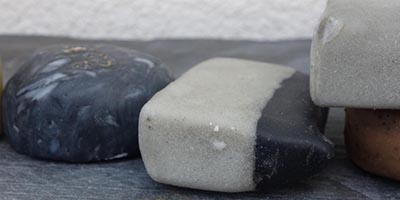
- Before mixing the liquid and lye, your liquid should be cold. Once yous add together these ingredients together, the exothermic reaction will crusade the mixture to heat up to temperatures upwardly to 200 degrees F. So, if you lot beginning off with a warm or hot liquid, it could get manner also hot. Use "fridge cold" water.
- When mixing liquid and lye, always add the lye to the water rather than pouring water into the lye, which tin can cause a small explosion.
- Practice this in a well ventilated surface area as information technology will give off fumes. Gradually add together the lye into the cold water, stirring until it dissolves well.
- Yous'll desire to embrace this mixture with a fabric and let information technology cool until about 110-120 degrees F which can accept one or more hours.
Phase 2: Fats
- Your fat will need to exist melted and heated to most 100-110 degrees. When you combine your lye mixture with the fats, it will heat upwards once again and if either ingredient starts off likewise hot, it can cause an expansion and spilling over of the mixture once poured into the mold or create unwanted textures in the final production.
- I have found that the optimal temperatures are when my lye liquid is 120 degrees and my fats are 110 degrees F, but in full general they should be within 10 degrees of each other.
- To time this properly tin can takes some practice. I will make my lye liquid first, then heat my tallow from solid. Ordinarily, I tin can fourth dimension this so the fat is liquid and cooled slightly by the time the lye mixture is cool enough.
- You tin as well use this cooling time to ready your other ingredients. Take your mold ready and your essential oils measured equally well every bit any other ingredients you may be adding.
Phase 3: Fat & Lye
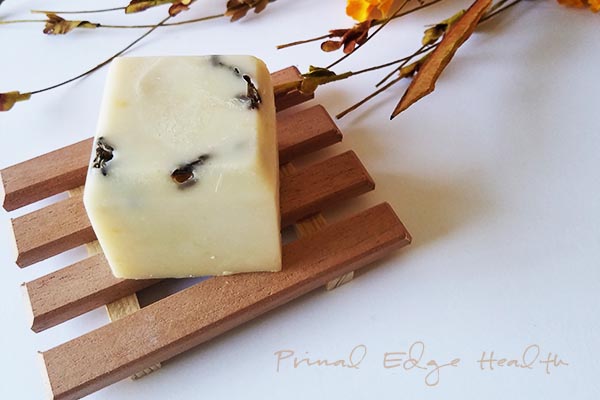
- Have your liquid fats in the bowl that you will pour from into the soap mold.
- Slowly pour the lye mixture into the fats, stirring constantly.
- From here, we are looking for the mixture to reach what is called Trace, a pudding-like consistency. You can reach trace simply past stirring and stirring, but depending on the size of your batch, this could have 30 minutes or more. A more than efficient way to reach trace is to utilise an immersion blender. I like to use the blender in brusk, 3-five second bursts, then stir with a whisk, checking regularly for trace.
- Y'all desire to make certain you don't over-blend the mixture, as it can seize upward and go besides solid, making it difficult to cascade into the mold.
- You can look for trace by lifting up your whisk and letting the mixture drip onto the surface. If it leaves a mark beyond the surface, this is trace.
- One time at trace, you lot tin add your essential oils or other coloring ingredients yous may or may not be using. If you are calculation essential oils, I recommend bringing it to low-cal trace so that information technology doesn't seize up when you are stirring in the essential oils. Mix just plenty to alloy, then information technology is set up to pour into the mold.
Phase 4: Pouring into the Mold
- Silicone molds are very easy to use and remove soaps from. Otherwise, line your mold with parchment newspaper and use tape to seal off edges and hold in place, if needed. You'll demand to turn it upside downward and tap our firmly.
- Whether using a loaf mold or a tray of private molds, after pouring in your mixture you will demand to tamp out any air bubbling that could be hiding in the lather. Gently tap the mold against the table or shake side to side.
- Spray the surface with alcohol every bit that will foreclose soda ash, or a white film from forming on top. Soda as doesn't pose a problem other than it isn't very bonny, only if the lather is for your ain use only, y'all may not care.
- Insulate the mold for about 24 hours to allow the soap to absurd more slowly. Use two bath towels; i on top to cover and wrap the second effectually the sides. After 24 hours, remove the towels. If y'all are using minor molds, you can remove the soaps carefully at present. If you have a loaf mold, I recommend waiting another 24 hours to let it harden more before removing.
Phase 5: Cutting & Curing
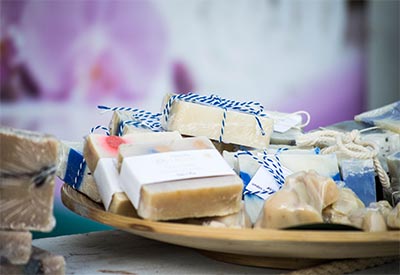
- If you take used a loaf mold, you will now demand to cut your loaf into bars.Don't await too long before cutting your loaf as it tin begin to harden and may scissure or crumble when it's cut.
- This doesn't demand to exist complicated and you lot can utilise a large knife to eye the size of each bar and mitt-cut. I dear the homemade look of an unevenly cutting bar of lather, but if your goal is to make them wait even and identical, you may want to invest in a simple soap loaf cutter which will assist y'all in making each bar the same size with a straight cutting.
Now, yous tin celebrate that you accept washed all the difficult work…but your soap isn't actual soap quite yet.
With cold procedure soap making, saponification will at present happen over a 6 to eight calendar week curing period. The chemic reaction needs to keep and the bars demand to harden and dry.
- Place your bars on a rack (a blistering cooling rack works well) in a absurd (not common cold), dark area that gets plenty of air flow.
- Stack the bars a few inches apart then they are not touching to allow for air to flow all the style around the soap.
- The smaller or thinner you have cut the soap, the quicker it will cure, but I find that a 1-inch bar is nice to hold onto and lasts a while.
- Subsequently six weeks, you can try out your soap. If it leaves your easily feeling slippery or if your skin stings at all, it'southward not set up.
Eight weeks may seem like a long fourth dimension to await for your homemade soaps, only the satisfaction of creating your ain production from beef fatty that may accept otherwise been thrown away is truly satisfying and worth the wait.
Once you understand the basic process of common cold soap making, there are endless varieties of soaps you tin make past calculation different essential oil combinations, experimenting with fatty and oil blends to attain different lather textures and adding natural botanicals and clays for color. Once you begin to handcraft your ain, unique soaps, I guarantee you that you'll never desire to purchase some other bar of store bought lather ever again.
If you are interested in making your ain lather, I know you will also enjoy homemade toothpaste too! The remineralizing Bentonite Clay Toothpaste has become my favorite.
FOLLOW Fundamental Edge Health on INSTAGRAM, PINTEREST and FACEBOOK for more simple DIY beauty and personal care recipes!
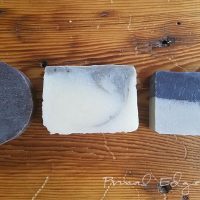
Rosemary Lime Tallow Lather Recipe
This recipe yields about one pound of soap and is 5% superfat. Yous could substitute whatsoever type of essential oil here if you lot want a dissimilar scent. Some other favorite combination of mine is Lavender and Black Pepper essential oil.
Print Pivot Rate
Servings: 1 pound of soap
-
Immersion blender
- 8 ounces beef tallow
- 3 ounces kokosnoot oil
- 3 ounces extra virgin olive oil
- 1.5 ounces castor oil
- 0.25 ounces rosemary essential oil added at trace
- 0.25 ounces lime essential oil added at trace
- two.fourteen ounces lye
- four.79 oz cold water
- 1 tsp clay optional, see notes
-
Gradually add the lye into the cold water, stirring until it dissolves well. Cover with a cloth and permit it cool until about 110-120 degrees F, can take 1+ hours.
-
Rut the fatty and other oils until liquid, then allow cool to 100-110F (38-43C).
-
Slowly pour the lye mixture into the fats. Alternate between using an immersion blender in short 3-v second bursts and stirring with a whisk. Check regularly for trace (see more in "TIPS" higher up). Do not over blend. If using clay, add during the last moments of mixing.
-
One time trace is achieved, cascade mixture into your mold (use a silicone mold or line with parchment paper).
-
Tamp out any air bubbles by gently tapping or shaking the mold against the tabular array
-
(Optional) Spray the height with booze if you want to prevent soda ash (purely for appearance to prevent any white moving picture on the tiptop).
-
Insulate the mold(s) with one-2 bath towels, 1 roofing the top and 1 wrapped effectually. Leave small individual molds for 24 hours, larger loaf pans sit down for 48 hours.
-
Popular soaps out of silicon molds or plough upside downwardly and tap firmly to release from mental molds.
-
Cutting i-inch thick bars with a sharp knife or lather loaf cutter.
-
Cure the bars for 6-8 weeks on a rack in a well ventilated absurd, night surface area. Each bar should be continuing lonely, not touching the others.
-
Test the lather after 6 weeks. If it leaves your hands feeling slippery or if your skin stings at all, it's not ready nevertheless.
Dirt is optional but it is one of my favorite additives to soap recipes. The clay leaves your peel feeling and so soft and it is as well a dainty and only style to accomplish subtle, natural-looking colors in your soaps. For a soft greenish, attempt french greenish clay or bentonite clay.
100% TALLOW To make a 100% tallow bar, just input the amount of tallow you lot would like to use for your recipe into the lye computer (1 pound of fatty per pound loaf mold). The figurer will then tell you how much liquid and lye to utilize. You will demand to select the "superfat" level yous desire for your finished production. This is referring to the percent of total fats that exceed how much will react with the lye, meaning that at that place volition be a modest percent of unreacted fats in your soap which will moisturize the skin. I like a five-half dozen% superfat, but if you were experimenting with laundry soap, y'all would want 0% superfat and so as to exit no fats on your clothes.
Tag a photo with @Primal_Mom and #PEHrecipe on Instagram to share with us!
This is a thoughtful souvenir for friends and family! If y'all want more ideas, check out Bath and Trunk Recipes that Make Great Homemade Gifts.
Then, endeavour all of my other easy tallow pare care recipes too!
Source: https://www.primaledgehealth.com/cold-process-soap-making-with-tallow-recipe/
0 Response to "Cold Process Soap Recipe Beef Dripping"
Post a Comment